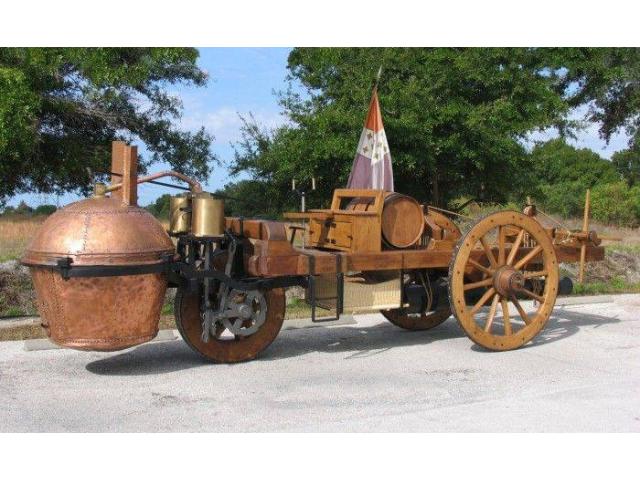1766 Steam Trike A Replica Of Cugnot’s
- Brand: Cugnot
Nicolas-Joseph Cugnot (26 February 1725 – 2 October 1804) was a French inventor who built the first working self-propelled land-based mechanical vehicle, the world's first automobile.
He was born in Void-Vacon, Lorraine, (now departement of Meuse), France. He trained as a military engineer. In 1765 he began experimenting with working models of steam-engine-powered vehicles for the French Army, intended for transporting cannons.
French Army Captain Cugnot was one of the first to successfully employ a device for converting the reciprocating motion of a steam piston into a rotary motion by means of a ratchet arrangement. A small version of his three-wheeled fardier à vapeur ("steam dray") was made and used in 1769 (a fardier was a massively built two-wheeled horse-drawn cart for transporting very heavy equipment, such as cannon barrels).
In 1770, a full-size version of the fardier à vapeur was built, specified to be able to carry four tons and cover two lieues (7.8 km or 4.8 miles) in one hour, a performance it never achieved in practice. The vehicle weighed about 2.5 tonnes tare, and had two wheels at the rear and one in the front where the horses would normally have been. The front wheel supported a steam boiler and driving mechanism. The power unit was articulated to the "trailer", and was steered from there by means of a double handle arrangement. One source states that it seated four passengers and moved at a speed of 2.25 miles per hour (3.6 km/h).
The vehicle was reported to have been very unstable owing to poor weight distribution, a serious disadvantage for a vehicle intended to be able to traverse rough terrain and climb steep hills. In addition, boiler performance was also particularly poor, even by the standards of the day. The vehicle's fire needed to be relit, and its steam raised again, every quarter of an hour or so, which considerably reduced its overall speed and distance.
After running a small number of trials, variously described as being between Paris and Vincennes and at Meudon, the project was abandoned. This ended the French Army's first experiment with mechanical vehicles. Even so, in 1772, King Louis XV granted Cugnot a pension of 600 livres a year for his innovative work, and the experiment was judged interesting enough for the fardier to be kept at the arsenal. In 1800 it was transferred to the Conservatoire National des Arts et Métiers, where it can still be seen today.
Two hundred and forty-one years later, in 2010, a copy of the "fardier de Cugnot" was built by pupils at the Arts et Métiers ParisTech, a French Grande école, and the city of Void-Vacon. This replica worked perfectly, proving that the concept was viable and verifying the truth and results of the 1769 tests.
Descriptions & pictures by siamagazin & Wikipedia & other
| Specification | |
| Production Start | 1766 |
| Country of origin | France |












